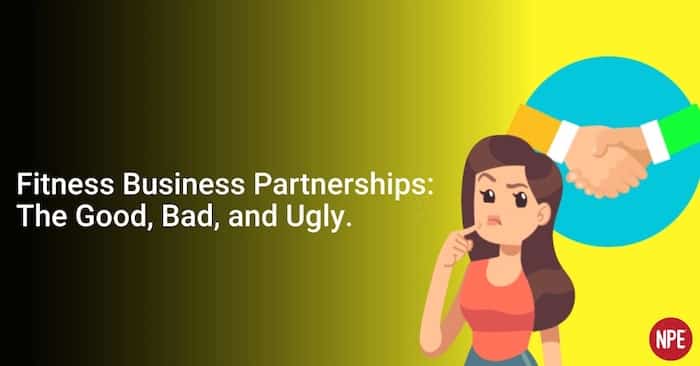Fitness Business Partnerships: The Good, Bad, and Ugly.
By Sean Greeley

We get a ton of questions on business partnerships. From professionals wanting to open a new business with their friends or family, to existing partnerships that have gotten difficult and not working out as planned, and everything in-between.
Whether you’re considering entering a new partnership, or managing an existing one… partnership relationships (like all others) take work. In this article we’ll break down the best ways to lead you to success… and clean up the mess when it’s no longer working out and you need to part ways.
+++++
We get a lot of questions about fitness business partnerships.
A lot of fitness business partnerships start out with friends who share a passion for fitness decide ‘let’s go into business together!’.
In the beginning it sounds like a great idea. If you can share resources, complement each other’s strengths, and share the workload as you grow together… everybody wins.
But partnerships can also come with a lot of challenges that too many people choose to ignore addressing until things get difficult… and by then things only gets tougher to navigate.
And when something as personal as a business and your incomes are at stake, you can’t just walk away easily when things get tough.
Here are just a few of the top challenges partners struggle with alignment (and misalignment) on:
– Values and mission: What do you stand for? What fires you up and why are you excited about starting and growing a business?
– Vision (personal and business): Where do you want to be personally and professionally in 1 year, 3 years, 5 years, 10 years?
– Work ethic: People may use the same words when they say “hard work,” but they may mean very different things. This also includes things like hours (time), intensity of focus and effort, and detail orientation.
– Attitude towards investment (and re-investment) in business growth: As revenue comes in do you share the same attitude on re-investment in the business tied to your vision and growth strategy? Growing businesses are like babies. They always want to be fed… but with cash!
– Expectations on personal income: Also tied to re-investment is your attitude and expectations around personal salaries and distributions. Are you aligned in your expectations? Are those expectations tied to a financial plan and budget that is practical for the business?
– Roles and responsibilities: Who does X? Who does Y? Ownership roles are very different from operational roles… and not all roles have (nor should always have) the same value to the business. It’s critical you clarify who does what, but watch out for assumptions and communication gaps. There are also issues of control and boundaries, as well as issues of personal responsibility that can crop up.
– Operational decisions: If a key decision has to be made about running the business (an investment or purchase, etc.) and there is a disagreement… who makes the final call?
– Exit strategy: One partner wants out or to take a deal, the other partner doesn’t. When are you willing to exit and why? Have you discussed it beforehand? How will a split decision be handled?
If you’ve read the list above and are thinking, “Wow! That’s a lot to think about!”, you’re right. Better to think about it (and have a plan) beforehand then discover halfway through you want to pull the ripcord (or worse, feel like you have no clear strategy and plan and you’re TRAPPED and can’t!) in a business partnership that has gone sour.
So let’s start with the first, big question:
1. Should you have a partner?
What are the advantages of having a partner?
You’re not alone “at the top.” Business is tough and surrounding yourself with others that complement your strengths and weaknesses, and help fuel your passion, can be a tremendous catalyst for growth and success.
Having a partner involved in the operations of the business with you means you also don’t have to make every major decision (and take all the risk) by yourself.
You may have complementary skill sets. Some may be better at executive work and another at programming. Some may be better at sales and marketing, and others love coaching clients and managing staff.
And sometimes, more is just more. More hands lighten the workload and allow for faster growth opportunities. Particularly when you’re just starting out.
What are the disadvantages?
It’s the flip side of “You’re not alone.” Depending on the structure of your relationship (and or operating agreement) you can’t just run your own show every step of the way. You have to coordinate decision-making and strategy. You and your partner may not align on priorities.
You may have different visions, even if you started out wanting the same things. As your business (and personal life) evolves, changes, and grows, you may see the way forward very differently.
On the finance side, you may have different thresholds for financial pain and different risk tolerances. If one person has a family dependent on the income, and the other just has to simply cover their own cost of living expenses, those are very different scenarios. Opportunities (and differences) may arise and it isn’t always easy to agree on which path to pursue.
2. What makes a good partner and a good partnership successful?
What makes a good partner?
Relationships work best and last longest when there are shared values. Your best alignment with a business occurs when both partners know and share the same values, and are also aligned on the “big picture”: That means both partners have shared vision, goals, purpose, and mission.
Relationships also work best when there are complementary skills. You both bring strengths to the table that make the entire organization stronger. Ideally, this will create ‘synergy’ – The whole can sometimes be greater than the sum of its parts. Great players make the players around them better.
Great communication skills are a must. Do both partners make the effort to communicate with one another or do they let things fall into “assumptive thinking” and hope for the best?
Emotional intelligence is also crucial. When present in both partners, self-awareness, self-regulation, internal motivation, empathy, and people skills allow conflicts to be avoided and resolved, and for the partners to gain momentum in the business.
Both partners also want to manage agreements more than expectations. Expectations, when unstated, are the killer. They generate powerful emotions. “I just expected when we could take a 7-figure exit, we’d take it.” It’s easier to manage an agreement than an expectation. Agreements are not emotional.
If you are creating a new partnership then take the time (and be patient) with establishing a shareholders agreement (and if appropriate a separate operating agreement) that clarifies how key decisions will be made, conflicts will be resolved, and how an exit (or death) of a partner will be handled. While these are uncomfortable conversations to be having, they are never easier to address than BEFORE they need to occur when a conflict arises.
3. How do I make my existing partnership better?
Your first step is to stand back from the situation and see where there is alignment and where there is not.
Get clear on the path forward in terms of vision, goals, purpose, and mission. It’s always good to review who you want to serve and why … in fact, as you grow your business, the more important it will be to get clear on things like ideal clients and messaging to them.
Engage in regular review of agreements and strategic planning.
Go seek counseling. We’ve seen a lot of business partners work through tough challenges by involving a professional that helps everyone to navigate communication and work through conflict in the relationship.
Work with a business coach. Having an outside expert support conversations around business strategy, opportunity, and more accelerates your success (which generally makes everyone happy). It also allows for personal and professional growth and development on all sides to continue (which lack thereof is generally what stalls business growth, and leads to unhappy partners!).
4. ‘The Ugly’: How do I break up?
First off, take a deep breath. It’s OK.
Just because partnerships end doesn’t mean you’re bad people.
And take the time to really ensure this IS the right time to end the partnership by consulting and/or working with a counselor and/or business coach.
But if it is time for a transition to occur, remember that not all (and in fact most) business partnerships last forever. This just means that what was once working for both parties isn’t working any longer. We need to have ways to untangle that and support everybody in their future.
Here’s some options to consider with a business transition:
– You can sell the whole business. This is pretty common, but often there are non-compete clauses that limit your future freedom.
– One side can buy the other out. (Make sure you figure your new payments into your cash forecasting). Don’t forget non-compete.
– You can close the business. This may be challenging given the business’s liabilities, leases, etc.
In the case of a business buy out, if there isn’t already a predetermined formula for business valuation and terms of sale to the other party… then seek out an independent third party to help everyone align around the valuation numbers and terms. Be patient with this process. It can take weeks or months to unravel, and that’s ok. There’s a lot involved and a lot to process (emotionally, mentally, and physically) when things reach this point. In the meantime, take the high road to treat each other, your staff, and your clients with care as you establish the appropriate path forward for all parties.
And above all, do your best to treat others with kindness and respect (and represent yourself by your values) even when you feel the other party isn’t always doing the same.
Take the high road whenever you can. But don’t allow yourself to be bullied or taken advantage of either. Seek help when needed.
Summary
Should you have a business partner? First, start out taking a look with the eight top challenges of fitness business partnerships. Decide whether you would prefer to run your own show, or if you’d rather share the billing and the decision-making. Look for alignment in as many areas as possible, but understand that you must align on values if the relationship is to last.
You can also use the issue of alignment to make existing partnerships better. You can look at where you work well together, and what skills individually and together you need to improve. This can be taken as far as counseling — some business partners have thrived when they’ve talked things out with a professional and allowed issues to surface and be resolved.
Finally, there’s the breakup. It doesn’t make you bad people. But you will need to act. Your options will be to sell the whole business, close the whole business, or one partner buys the other out. And of course, treat everyone with kindness and respect. Take the high road.







